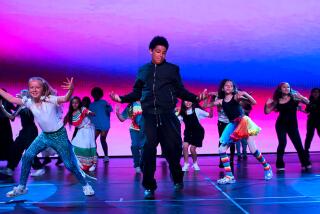‘Moses’ Tries to Reach Out to the Uninitiated
- Share via
There’s some frightening talk going around about Loretta Livingston and Dancers’ “Grandma Moses Project.” Unsettling words such as “modern dance” and “tribute,” which, when used in the same sentence, can cause otherwise-sensible parents to avoid the performance like car-pool duty during Friday rush hour.
But take five.
A conversation with the company’s manager, David Plettner, revealed that the one-hour piece, which will be presented Wednesday at the Orange County Performing Arts Center as part of the Imagination Celebration, was designed specifically with families in mind, especially those unfamiliar with modern dance.
In fact, based on Plettner’s observations, adults might be more put off than their children by the prospect of an evening-length, modern dance concert.
“Through our outreach work in schools, we’ve found that children appreciate sophisticated, fully staged concert dance as long as it’s about something they can relate to,” Plettner said by phone from the company’s Los Angeles studio.
“Look at what’s happened in children’s theater,” he continued. “In the last 10 to 12 years, we’ve seen more works which are challenging, interesting and have vibrant content. The same things can be translated into dance.”
We should immediately clarify that though this piece is inspired by the works of American folk painter Grandma Moses (a.k.a. Ann Mary Richardson, a farm wife who took up painting in her 70s and continued until her death at 101), it bears no resemblance to that other tribute to famous artists, Laguna Beach’s annual Pageant of the Masters.
According to Plettner, the dances in “The Grandma Moses Project” are not literal re-creations of the artist’s paintings, and they are definitely not static.
“There are occasionally tableaux drawn from the paintings, but they are just moments,” Plettner said. “Many choreographers use stillness as contrast. Nor are we trying to tell the story of the painting. It’s the layering . . . of meaning which makes the experience more evocative.”
Instead of telling the story of individual paintings, Plettner said, the dances convey the spirit and vision of the artist by bringing to life characters and situations seen in her works.
“Because (the paintings) are literally scenes from country life, fall harvest scenes, planting scenes . . . the dance is divided into four seasons,” Plettner said. “In summer, for example, there is a stylized baseball game, a picnic, a Fourth of July parade--all recognizable activities that are depicted in the paintings.”
“The Grandma Moses Project” premiered in March 1993 at the UCLA Center for the Performing Arts and is the fruit of a yearlong collaboration by Livingston, Swiss composer Murielle Hamilton and Martha Ferrara, dean of the Cal Arts school of theater.
Though it has its basis in late 20th-Century music, dance and visuals, the creators drew much of their inspiration from American country life nearly 100 years ago, Plettner said. Modern dance interpretations of contra and folk dancing are seen in Livingston’s choreography, and Hamilton’s music includes styles ranging from Aaron Copland and turn-of-the-century hymns to folk music.
Instead of the minimalist look often associated with modern dance, Ferrara’s richly colored costumes were created using 1890 clothing patterns, and her setting features a changing quilt-style backdrop modeled after a Grandma Moses landscape. Period farm and household items are used as props.
Audience participation is blended into the show as well. In one scene, viewers help dancers move farm tools in preparation for work in the fields.
The six-member cast, which includes Livingston and Plettner, portrays a “family unit” of a mother, father, two young girls and male and female hired hands. Although viewers could interpret it as such, the characters aren’t meant to portray Grandma Moses’ own family (the artist, a mother of 10, met her husband while both were working as hired hands on a farm).
“The important thing is the impression that there is this wonderful family interaction,” Plettner said. “The children are playful, get in trouble, are obedient, work hard . . . they do things every parent and child can relate to.”
What: Loretta Livingston and Dancers present “The Grandma Moses Project.”
When: Wednesday, April 27, at 7 p.m.
Where: Segerstrom Hall, Orange County Performing Arts Center, 600 Town Center Drive, Costa Mesa.
Whereabouts: From the San Diego (405) Freeway, exit at Bristol Street and drive north. Turn right on Town Center Drive.
Wherewithal: Tickets are $4 for children and adults and can be bought at the OCPAC box office or by phoning TicketMaster. Advance purchase is recommended.
Where to call: For information (714) 556-2787, Ext. 888; for tickets, (714) 740-2000 (TicketMaster).
More to Read
The biggest entertainment stories
Get our big stories about Hollywood, film, television, music, arts, culture and more right in your inbox as soon as they publish.
You may occasionally receive promotional content from the Los Angeles Times.










